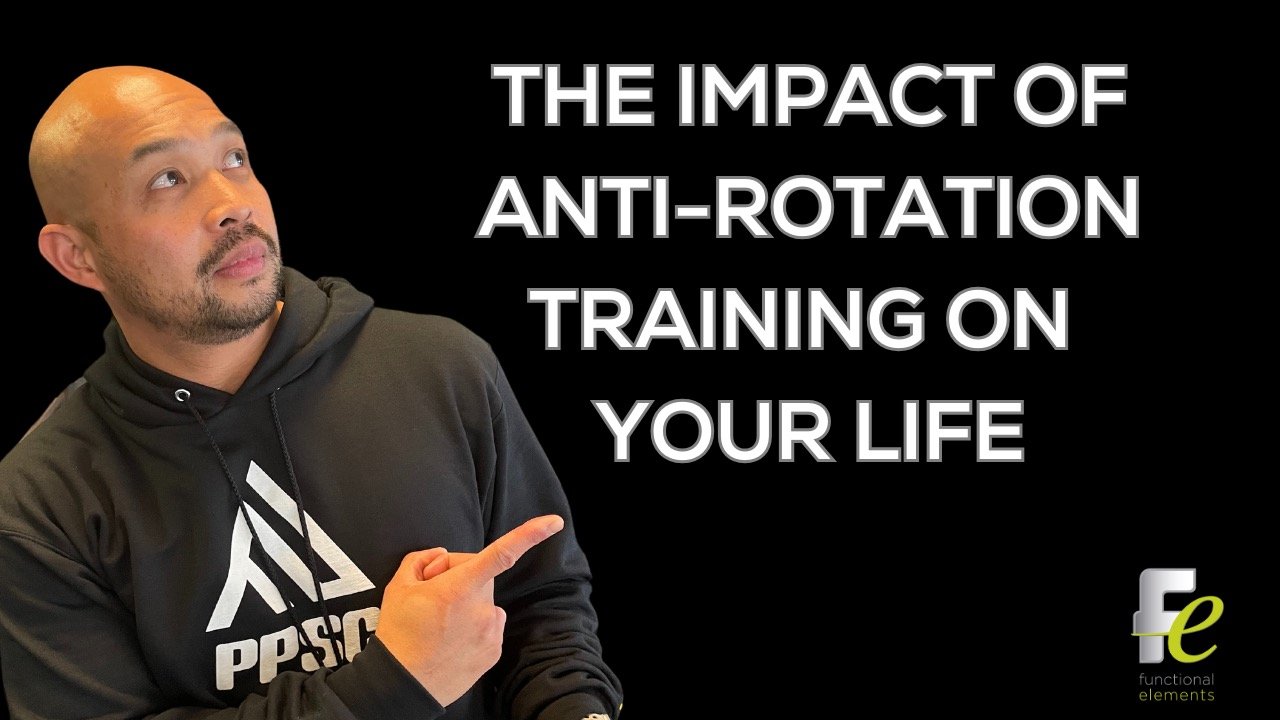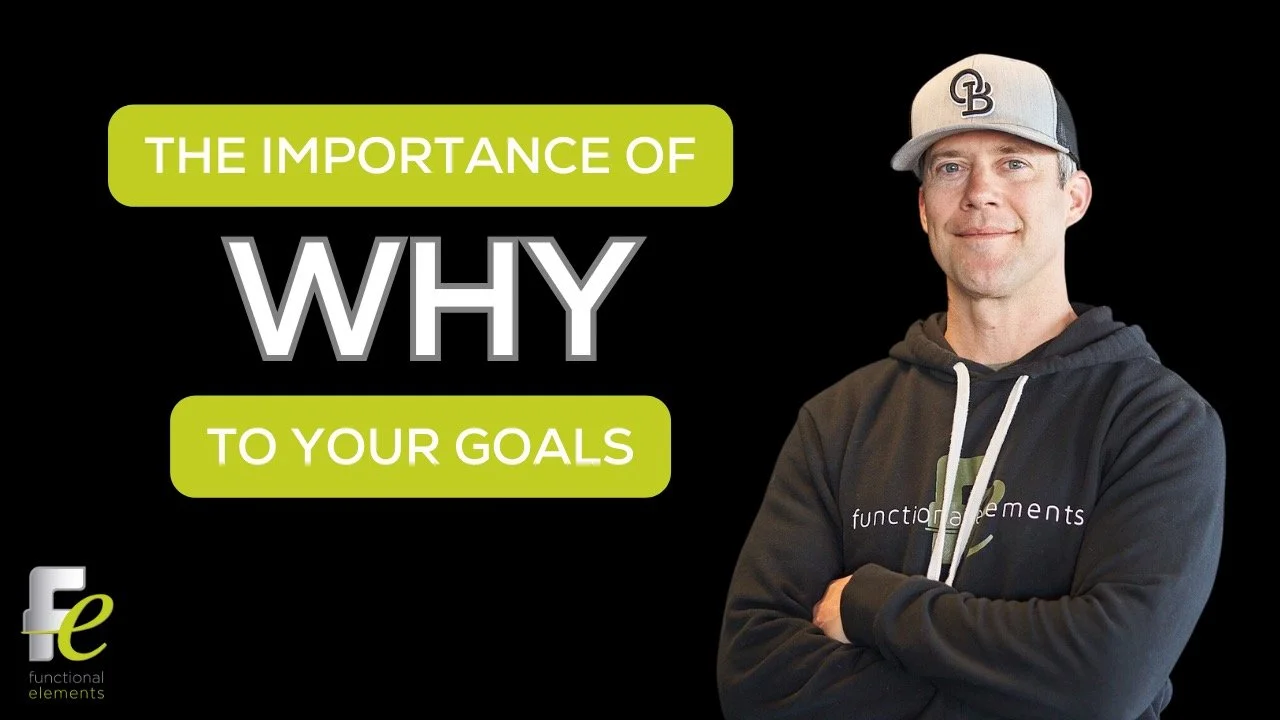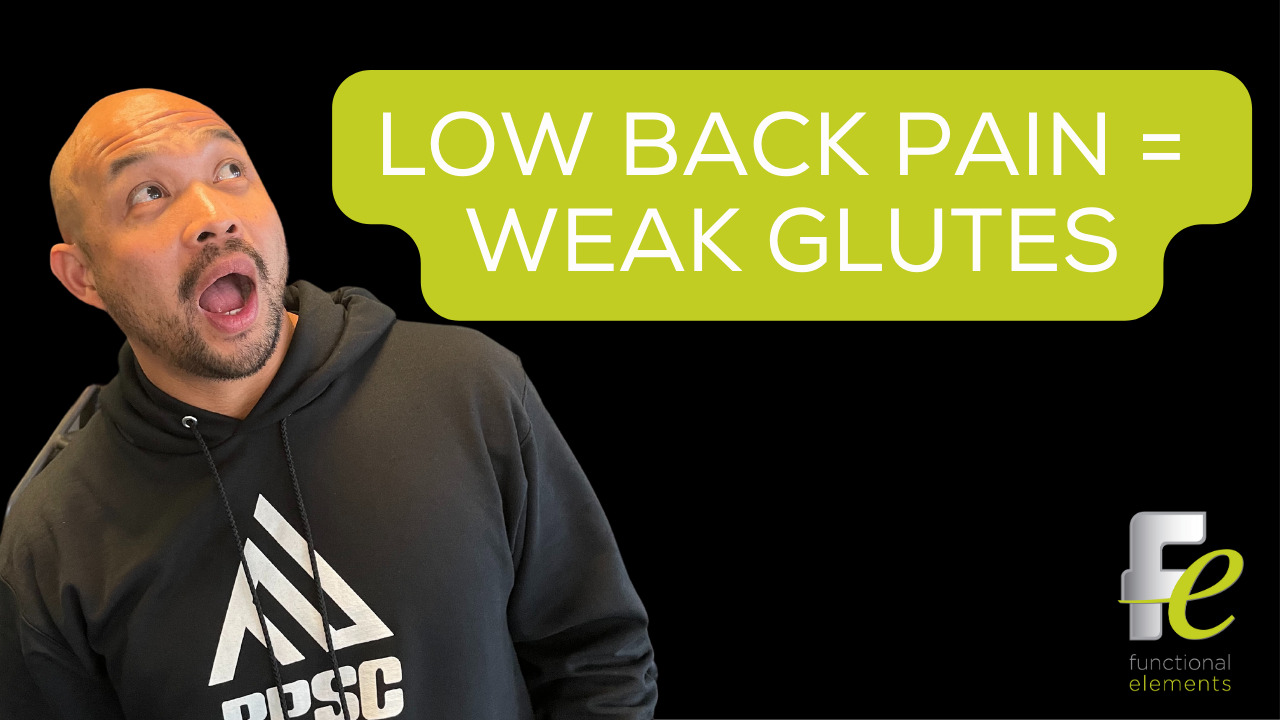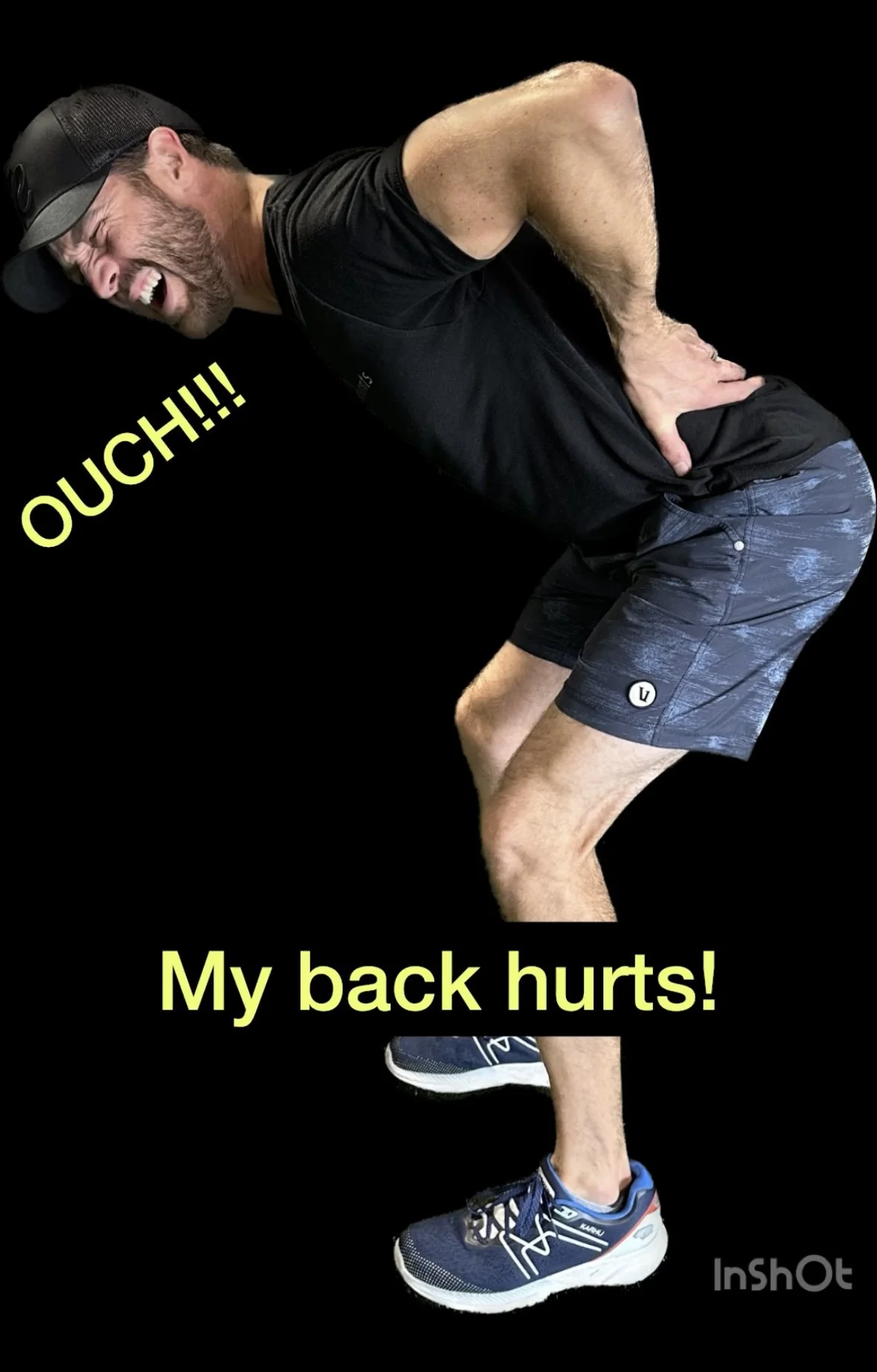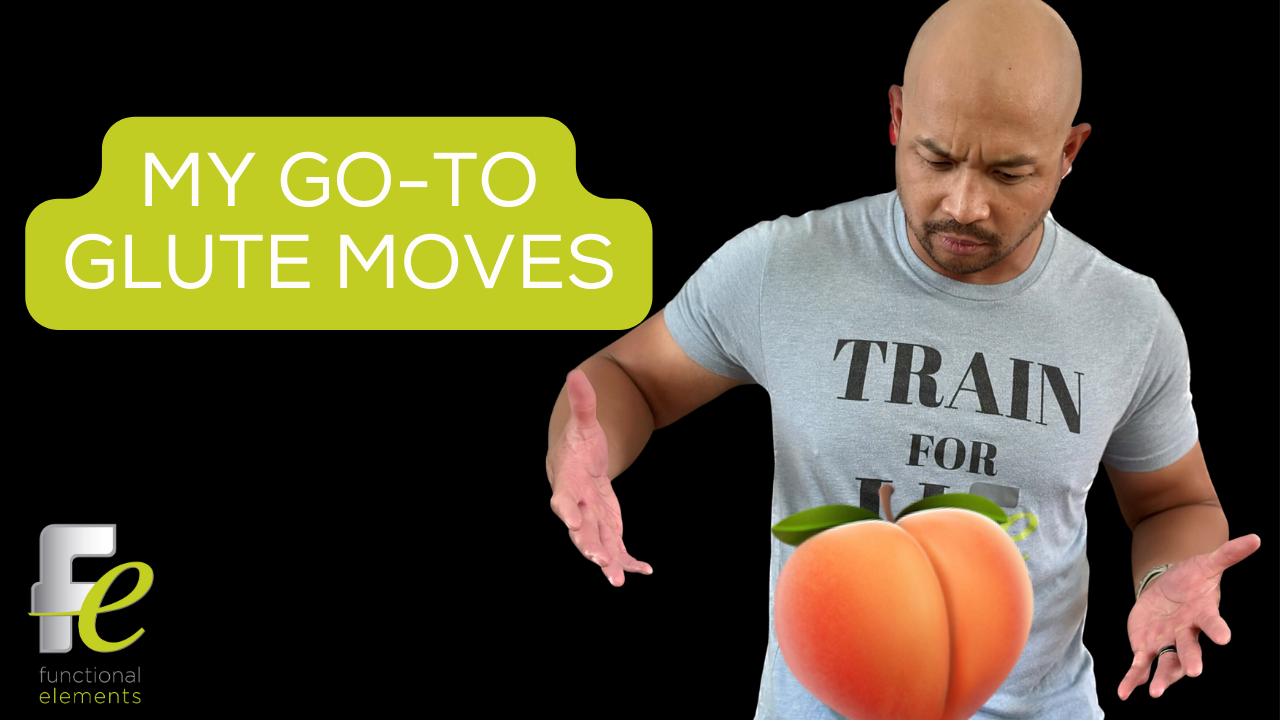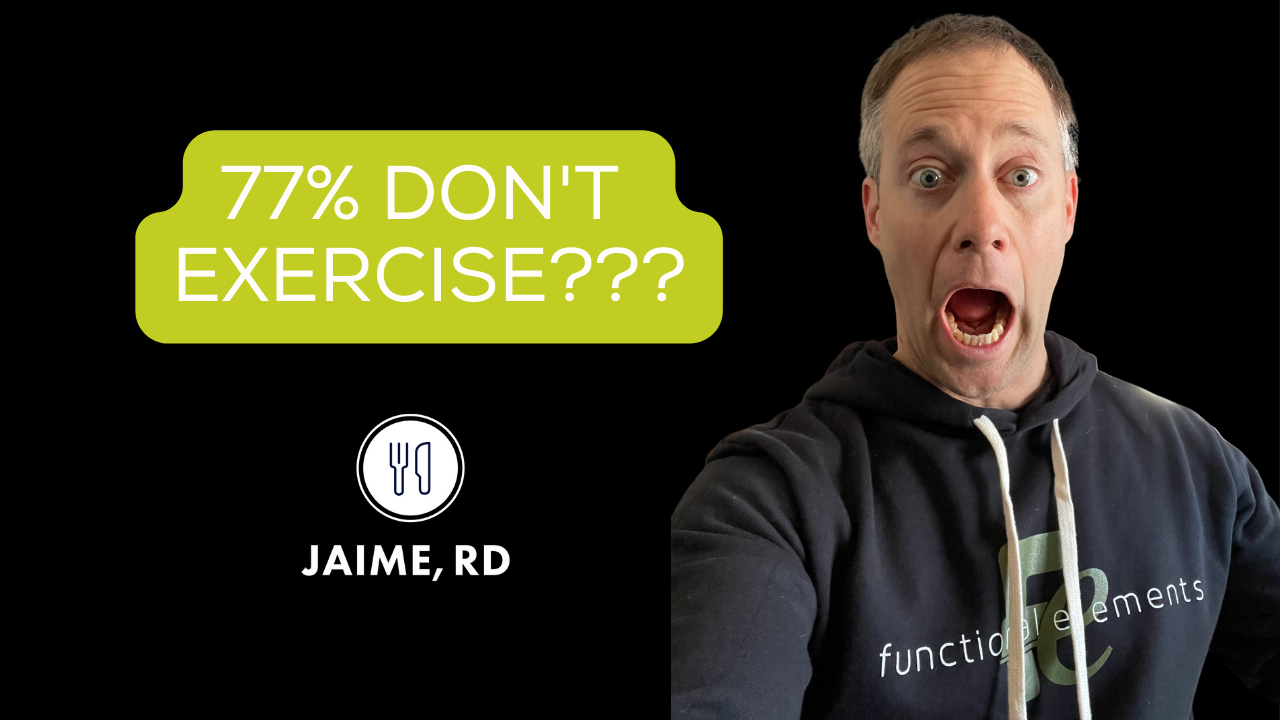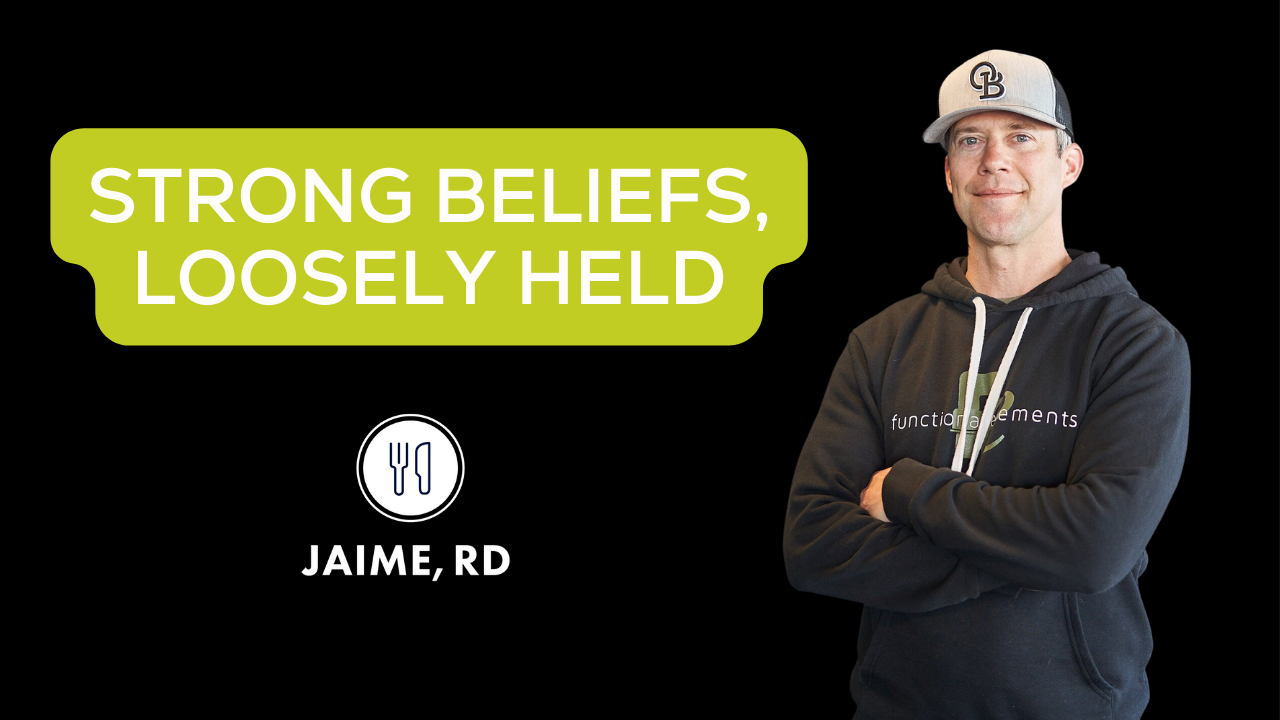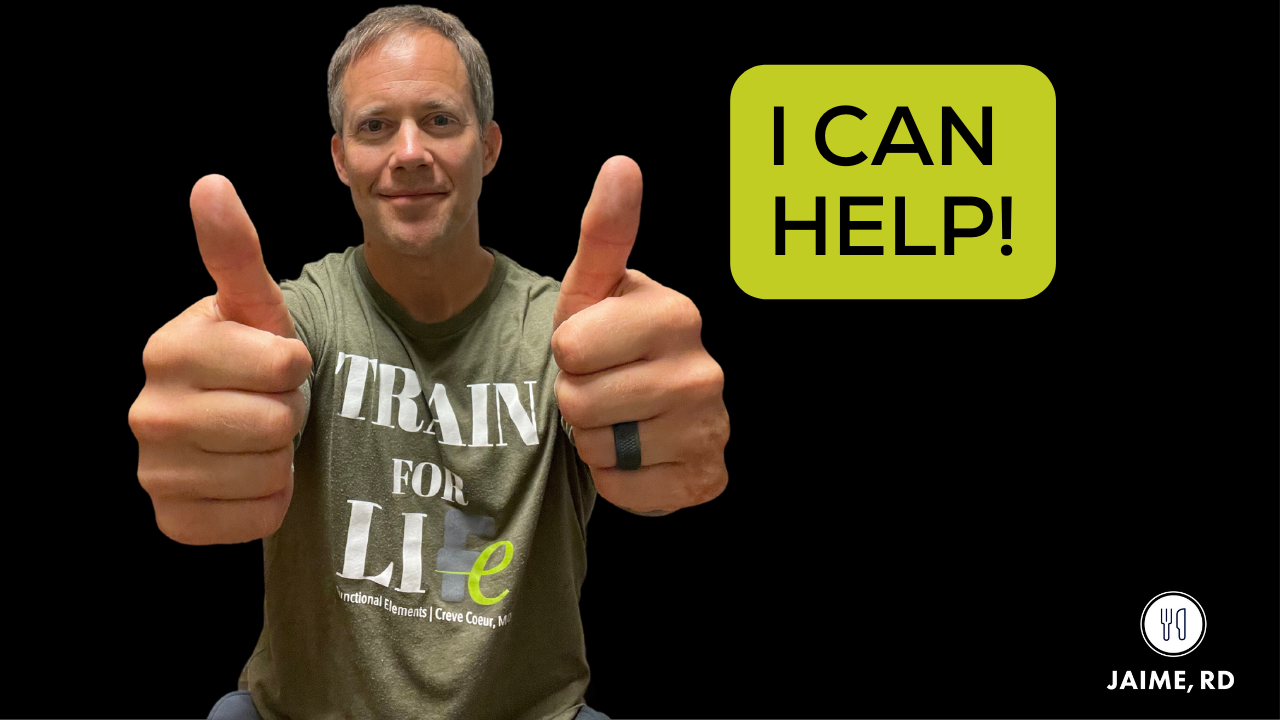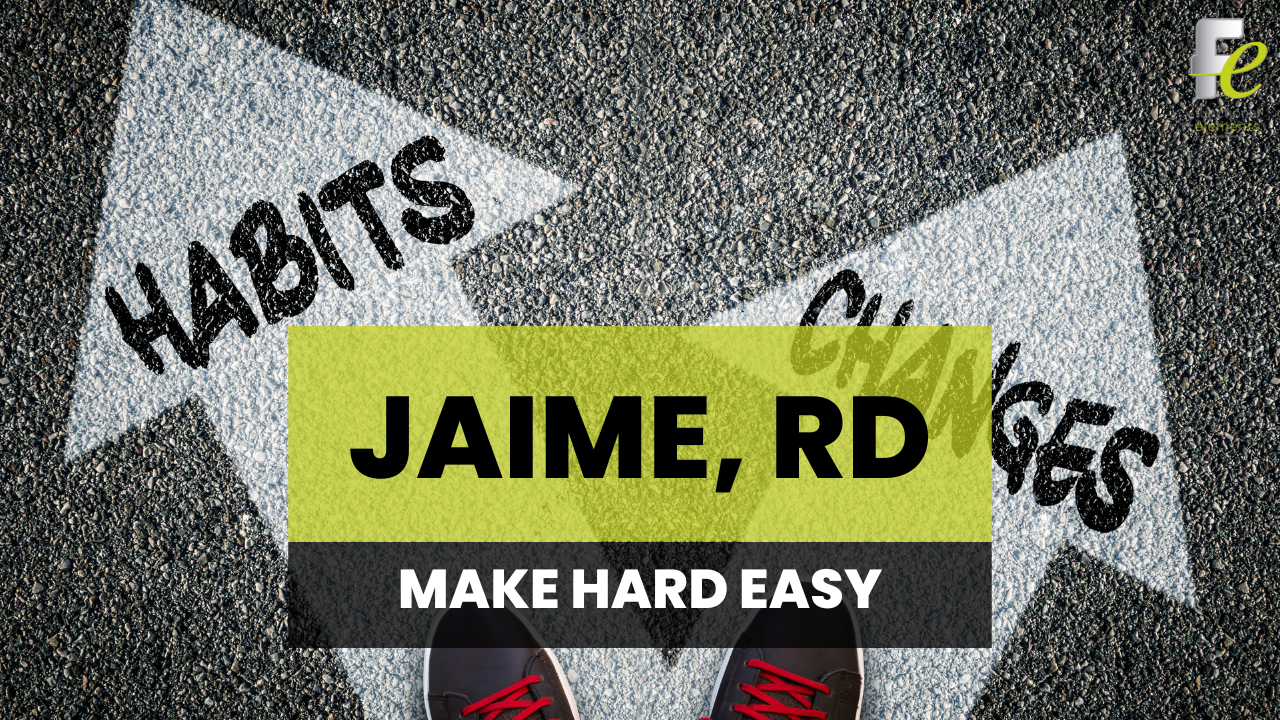It Really Doesn’t Matter….
First, it was low-fat.
Then, there was low-carb.
Detoxes and cleanses.
Very low-carb ketogenic.
And don't forget, macros don't matter, it's all about intermittent fasting.
For decades we've been trying to find the "best" diet for weight loss. In actuality, when calories are controlled, all weight loss diets work. Anyone trying to sell you on ONE revolutionary diet for weight loss that claims it works better than the rest is full of sh*t.
When we transition away from this magical diet our results typically disappear as well.
"Keto worked for me and I lost 30 pounds!"
"Great! And you kept it off?"
"Well, no, I gained 35 back."
(In my mind..."So it didn't REALLY work for you.")
So the next time social media, a magazine, or gym bro touts this or that diet works better for everyone, have confidence it's all nonsense. And any diet that cannot be followed long term is useless.
I challenge you, from this point forward, to take into account YOUR goals, preferences, and make educated decisions to find what works for you in your weight loss journey.
One size does not fit all!
As always,
GIVE YOUR BODY WHAT IT NEEDS, WHEN IT NEEDS IT.
Confused on where to start?
The Functional Elements 14-day 360° gives you everything you need, over 14 power-packed days.
Why Anti-Rotation is Key to your Training
Why Anti-Rotation is Key to your Training Program
Imagine waking up to a sunny, cool fall morning. You feel great and energized and take advantage by taking your best four-legged friend on a neighborhood walk.
You tie up shoes, attach the leash, and open the door, only to be welcomed by a squirrel at your front yard. Your dog sprints out to attack the squirrel, violently pulling you with him. You try to chase after him, but you struggle because of a shooting pain in your low back, ruining your morning, day, week, and even month.
This scenario could happen to anyone. Thus, the importance of incorporation anti-rotation movements to your training routine.
Yes, everyone would love to have a six-pack, but don’t fall into the trap of thinking that is the main reason for core training. Your core is not just your abdominals. It also consists of your pelvis, low back, hips, and glutes. Its main function is to hold your body upright and to stabilize it. Thus, when an external force acts against you, your core needs to have the strength and stability to resist that force in order to prevent injuries.
Anti-rotation movements can do just that. Anti-rotation (and anti-extension) exercises train the core muscles that control the transverse and sagittal plane movement of the spine, rib cage, and pelvis. Anti-Rotation is great for building core stability and enhances your body’s ability to resist force. It involves contracting your core and holding it completely still while keeping your body within just one singular plane, or direction of motion.
Here are some of my go-to anti-rotation exercises:
Pallof Press
Kneeling Halos
Mace/ Lever Bell Side Press
Off-Set Resistance Squats and Hinges
Bird Dogs
Dead Bugs
So, make sure you incorporate anti-rotation into your training program. It will not only help build core stability and prevent injuries, but it will also make your stronger in other exercises and help build a better mind/body neural connection. You will have the strength and stability to hang on to that dog leash, as Fido attempts to attack that squirrel. Get’em boy!
As always,
GIVE YOUR BODY WHAT IT NEEDS, WHEN IT NEEDS IT.
Confused on where to start?
The Functional Elements 14-day 360° gives you everything you need, over 14 power-packed days.
We got a situation!
We got a situation!
Forty-one year old woman...two kids...career...husband (that acts like a child...just kidding!)...and now it seems as though, all of a sudden, some unwanted physical changes are happening.
"My hormones must be changing."
"My metabolism must be slowing."
Could it be hormonal changes? Possibly. Is your metabolism slowing down? Probably not (this really isn't significant till after the age of 60).
Many times, in situations like this, we like to search for extreme answers as to why things are changing. However, I've observed that the 41 year old mom with 2 young kids, career, PTA, and everything else that comes along with all of this creates a stage of life that's busier than any other.
In this season of life so much is going on that YOU are put on the back burner, which means your health, weight loss, strength. and general well-being may suffer.
It's obviously not on purpose. The focus and busyness of kids, family, career and other events involving friends in the same boat is most likely precipitating this unwanted change. It's a lifestyle that makes change harder.
Time is a commodity, your food environment offers many more temptations, and the mindset isn't about you.
So how do you manage all this and still take care of yourself?
My advice: Be selfish! Yep, you read that correctly. Selfish doesn't mean neglectful. But it does mean that boundaries need to be established and you must carve out time for yourself and rely upon discipline (because motivation isn't going to cut it when you only have some much energy and bandwidth to give).
If you only have 30 minutes, 3x/week to walk or strength train, then make it non-negotiable. Or, if you need 15 minutes to get your lunch ready for the next day, the load of laundry can wait a few minutes, or ideally, be delegated to someone else in the household (I’m not going to name names).
No doubt, it's a difficult stage of life to care for yourself, but it can happen by moving YOURSELF up your own list of priorities.
As always,
GIVE YOUR BODY WHAT IT NEEDS, WHEN IT NEEDS IT.
Confused on where to start?
The Functional Elements 14-day 360° gives you everything you need, over 14 power-packed days.
Cardio or Weights for Weight Loss?
"I WANT TO LOSE WEIGHT!"
"Should I do more cardio?"
Maybe.
"Should I do more strength training?"
Probably.
What many don't realize is that the TYPE of training has little to do with the ABILITY to lose weight.
The type of training has more to do with where the weight loss comes from.
Is it coming from muscle? Is it coming from glycogen stores? Or is it actually coming from fat stores?
In actuality, any activity can foster weight loss as long as other critical factors like nutrition, sleep and stress management are aligned.
Ideally though, we want to spare as much muscle as possible in the process.
My best advice is to use exercise strategically, and to stop using it to chase calories for weight loss.
Strength training will create strength and stability from muscle growth or maintenance.
Use it for this purpose.
Endurance or cardiovascular exercise will develop aerobic capacity and heart health.
Use it for this purpose.
Both types of training are necessary and will contribute to overall health (and possibly weight loss).
And if you're not losing weight, well, I have a strong inclination it's not the TYPE of training you're doing but a factor OUTSIDE of training.
For example, you may be training with your coach four hours per week. Remember though, there's another 164 hours in that same week
that also need your attention (that's where those OTHER factors I mentioned previously come in ... diet, sleep, stress management).
And if you can, find a qualified coach that can guide and support you (I happen to know of some good ones!) through the 164 hours outside
of training to help facilitate a complete strategy to make sh*t happen!
As always,
GIVE YOUR BODY WHAT IT NEEDS, WHEN IT NEEDS IT.
Confused on where to start?
The Functional Elements 14-day 360° gives you everything you need, over 14 power-packed days.
The Importance of your WHY
Functional Elements has been helping our awesome clients on their health journeys for 10 YEARS now. Over these ten years there have been, and are, a couple commonalities amongst the majority. What would those be, you ask?
1. I want to lose weight
2. I want to get stronger!
Though different, these two goals are linked. One of the thought experiments we go through within each new client's initial strategy session is simply asking the question, "Why?".
Why do you want to lose weight? "Because I want to look better."
Why do you want to look better? "So I can have more confidence in myself."
OR
Why do you want to get stronger? Because I don't feel like I'm as mobile as I once was?"
Why do you want to be more mobile? "Because I want to still be able to hike and play tennis with my family."
THERE IT IS!
The goal isn't really JUST to lose weight or to gain strength. It's always much deeper than that. It is about self worth, as well as the things that lead to more fulfillment...being able to do the things you want when you want to do them. Live a long and healthy life with your family. Have the ability to play with your kids and it not be a struggle. Or, having confidence in oneself (wear what you want to wear...do what you want to do.).
These deeper feelings? Well, these are your anchors. It's not as simple as "I want to lose weight."
If this sounds familiar to you, then start taking steps to reach your anchor (not just your goal).
Remember, these steps don't need to be complicated or difficult. However, you MUST have a game plan regarding exercise (strength training is you're trying to get strong) and nutrition. And, if you've been struggling on your path to health for a while, then it's time to take it out of your own hands a seek professional help. Maybe not only for the expertise and experience, but for the accountability as well. Seeking out a coach that will put the correct, and most efficient, plan together and push you to be consistent in all aspects of improving your health is always a good idea, though we all typically think we can just do it on our own.
For example, my fields of expertise are in training and nutrition. However, if I want to get better or dive deeper into a specific aspect of training, namely kettlebell training, then I better seek out someone that knows more than me. This closely applies to the two most common goals our clients seek us out for...getting stronger by building muscle, and weight loss (more specifically, fat loss).
It's time for a new way. If not with Functional Elements, then find someone good that can help you actually reach your anchor and stop spinning your wheels.
As always,
GIVE YOUR BODY WHAT IT NEEDS, WHEN IT NEEDS IT.
Confused on where to start?
The Functional Elements 14-day 360° gives you everything you need, over 14 power-packed days.
Low back pain =Weak Glutes
Low Back Pain = Weak Glutes
In my 20 years of training, by far the most common chronic pain our clients experience is low back pain. Due to the structure of the human anatomy, the spine takes a lot of stress in daily movement. Low back pain can be caused by several factors, some of which can be poor posture, disc integrity, and poor mobility, to name just a few. Often though, since the human body is all connected, usually more than one factor is the culprit. If I were to pinpoint, however, one area to relieve low back pain, it would be to strengthen the GLUTES.
Why is the gluteus maximus the biggest muscle in the body? Because it has the important task of keeping us upright and pushing our bodies forward. The gluteus maximus also gets assistance from the gluteus medius and minimus. The gluteus medius and minimus work together to stabilize the hip which assists in balancing the body. Due to inactivity over time, glutes are weakened, and not stimulated, which then prevents this big muscular structure from efficiently keeping our bodies upright and supporting our daily movement.
Because of its key roles in stability and movement, weak glutes can lead to low back pain and can even affect the hips and knees. So often in training, and especially with males, glutes can get ignored and the focus turns to chest, arms, and abs. Don’t fall into this trap. Incorporate proper and effective glute exercises to your routine. Here are my top 3 go-to glute movements with regressions and progressions:
1. Hip Thrusts
Why: great for overall gluteus maximus strength and teaching hip extension
Regression: Lying Glute Bridge
Progression: Single Leg Hip Thrust
2. Banded Clamshell
Why: often use physical therapy for pain management, it targets the glute medius and piriformis to strengthen the core and pelvic muscles
Regression: no bands, just bodyweight
Progression: Banded Lateral Walk or Standing 1-Leg Fire Hydrant
3. RDL w/ kettlebells, dumbbells, or barbell
Why: strengthens the posterior chain and can enhance daily movement and performance
while reducing back pain
Regression: bodyweight or anterior loading
Progression: Single Leg RDL
So next time you grab that low back to relieve that dull ache, ask yourself, “have I worked and stimulated my glutes?” Train your glutes consistently! Your body will thank you for it. Glute Demos
Remember to always #TrainforliFE.
You want strong glutes and a pain free lower back? Contact us @functionalelements
As always,
GIVE YOUR BODY WHAT IT NEEDS, WHEN IT NEEDS IT.
Confused on where to start?
The Functional Elements 14-day 360° gives you everything you need, over 14 power-packed days.
Tony Muyco III, CSCS, PPSC, PPSC*KB, CFS
Got Low Pain?
Low back in pain? Tired of having a stiff back? Try these three movements consistently and simply feel better.
Here are Ryan’s top 3 mobility exercises to help alleviate low back pain…
1. Cobra Raise
2. Lying Supine T-Spine Rotation
3. Alt. Knee Hugs
Preform each of these for :30 (:30 each side for T-Spine Rotation.
If you wake up with low back pain, this routine is for you!
Give it a try! MY BACK HURTS
For more information, contact us @functionalelements
Jaime’s Homework Assignment
Over the past year or so I've been preaching progress over perfection. A LOT.
And how simple tasks performed consistently are the real needle movers.
Which leads me to a little homework assignment I have for you.
The assignment is based upon what I consider the FOUR basic pillars of health...EXERCISE...NUTRITION...SLEEP...& STRESS MANAGEMENT.
For the next seven days I want you to implement ONE task in each category and evaluate how you feel.
1. NUTRITION:
Eat a good protein source 3x/day and include 2 vegetables per day (or 1 fruit and 1 vegetable). If you're already achieving this, up the protein by 10-15g/day and one more fruit or vegetable.
2. EXERCISE:
If you're not exercising consistently at this point, it's okay. It's never too late to start. So, start by moving for 20 minutes each day. Don't worry about what it is ... JUST GET MOVING and find something you enjoy!
3. SLEEP:
Try to achieve a minimum of FOUR sleep cycles. Each cycle is about 90 minutes, so four of them equals 6 hours. Five cycles would be better (7.5 hours). However, waking up in the middle of a sleep cycle may result in grogginess or sluggishness so try to wake up at the end of a 90-minute cycle.
4. STRESS MANAGEMENT:
Each of us handles stress differently, but my recommendation for this week is to simply read 20-30 minutes per day of a fiction book of your choice. Make it juicy and get out of your head for a few minutes.
Again, implement just ONE task in each category for seven days.
Then, evaluate how you feel.
Simple, right?
The compounding effect of small changes within each of these categories, coupled with performing these tasks consistently, can create exponential results.
Don't underestimate the power of...
EASY TASKS + LESS COMPLICATION = MORE ACTION PERFORMED CONSISTENTLY OVER TIME!
As always,
GIVE YOUR BODY WHAT IT NEEDS, WHEN IT NEEDS IT.
Confused on where to start?
The Functional Elements 14-day 360° gives you everything you need, over 14 power-packed days.
Tony’s Top 3 Glute Crushers
Why is the gluteus maximus the biggest muscle in the body?
Because it has the important task of keeping us upright and pushing our bodies forward …
Why is the gluteus maximus the biggest muscle in the body?
Because it has the important task of keeping us upright and pushing our bodies forward.
It gets assistance from the gluteus medius and minimus muscles. The gluteus med and min work together to stabilize the hip and help us balance.
Because of its key roles of movement, weak glutes can often lead to pain in the lower back and knees.
The following three exercises are my go to movements for glutes ...
1. Hip thrust: great for overall strength and hip extension.
2. Clamshell: often used in physical therapy because it targets the glute medius and piriformis, strengthening the core and pelvic muscles.
3. RDL: strengthens the posterior chain, which can enhance daily movement and performance, while reducing back pain.
As always …
GIVE YOUR BODY WHAT IT NEEDS, WHEN IT NEEDS IT.
Ready to kickstart your own personal fitness journey?
The Functional Elements 14-day 360° is a great place to start.
Click here for details.
J. Antonio Muyco III
NSCA, PPSC*KB, CSCS, CFSC
Functional Elements Fitness & Nutrition
TRAIN FOR LIFE
77% of the U.S. Population Doesn’t Exercise!
There's a ton of health and fitness information loaded on us from all directions. Cardio vs. Strength training? Keto vs. Vegan? Remember this, it doesn't need to be a binary war...one or the other.
There's a ton of health and fitness information loaded on us from all directions. Facebook, Twitter, Instagram, Google, TikTok, the "experts", the news, friends, and family all seem to have a dogmatic opinion about aspects of nutrition and exercise.
Cardio vs. Strength training?
Keto vs. Vegan?
Remember this, it doesn't need to be a binary war...one or the other.
There's nuance, differing situations, and complexities that determine the best choices for each of us.
The debate about what type of exercise and nutrition program is superior has been endless. And we've taken a very narrow view of these realms
The 10,000 foot view is less complicated and doesn't require any of us to die on the hill for a particular training (or nutrition) ideology.
As a dietitian, I believe nutrition plays a huge role in our health and must be a large component of our health span.
But, exercise may be a greater determinant of how we will end up.
There is so much data supporting how exercise (even in small amounts) delays the onset of chronic disease.
It obviously slows physical decline, but can slow and even reverse cognitive decline. Not to mention the benefits incurred for our emotional health.
(There are not many things better for you to decrease stress than a good workout!)
If I can encapsulate ONE takeaway:
If you already exercise, great! Keep it going and don't be dogmatic about your exercise choice.
You need strength training. But you also need cardio. You need it all.
So, the next step is to modify and figure out the correct program that will let you reach a better health span.
If you don't currently exercise, you're not alone. Seventy-seven percent of the US population doesn't exercise.
Yes, 77%!
Lucky for you, it's never too late to start and see and feel the benefits of exercise. These benefits come from as little as 90 minutes per week (30 minutes three times per week; 15 minutes 6 times per week).
Going from zero minutes per week to even this small amount and you can find yourself reducing your risk of all cause mortality by 14% (i.e. you're going to reduce your risk of dying from everything and live longer).
FIND A DRUG THAT CAN DO THAT. IMPOSSIBLE!
As always,
GIVE YOUR BODY WHAT IT NEEDS, WHEN IT NEEDS IT.
Jaime Rothermich
RD CSSD LD PPSCxKB CSCS
Functional Elements Training & Nutrition
TRAIN FOR LIFE
Is Functional Elements Right For You?
The 14-day 360° gives you 14 power-packed days to find out.
START NOW
Strong Beliefs, Loosely Held
Beliefs around nutrition have been ingrained in us for years, possibly starting at very early ages. When we keep hearing the same message over and over and over again (whether it's right or wrong), it's in our psychology to begin to believe this message …
Beliefs around nutrition have been ingrained in us for years, possibly starting at very early ages.
When we keep hearing the same message over and over and over again (whether it's right or wrong), it's in our psychology to begin to believe this message.
Certain nutritional information seems to be reaching ideological status for large swaths of our population.
Or, even if we logically understand the truth about the information, there's something in us that doesn't allow the change in belief.
For example, carbs make people fat!
This message was constant for quite some time and still continues today, even with evidence showing otherwise.
And I admit, I was guilty of this belief like many.
But, I was, and always will be, willing to change my mind based upon new and better evidence.
So what does the evidence show regarding carbs making us fat?
A. Low-fat diets were slightly more effective at lowering total cholesterol and LDL ("bad") cholesterol that is primarily associated with increasing risk of cardiovascular disease.
B. Low-carb diets were more effective at increasing HDL ("good") cholesterol which assists in protecting the heart.
C. NEITHER DIET was more effective than the other at reducing weight, blood pressure, glucose and insulin levels.
(Meta-analyses in the American Journal of Epidemiology, 176, supplement 7, Oct 2012)
Whatever your goals may be, whether overall improvement in health, weight loss, strength, etc., being strong in your nutritional beliefs is great.
But don't get so stuck in those beliefs and not allow yourself the ability to pivot, even in the face of stagnation or even regression.
Be open to new ideas and evidence. This is the path to continuing the advancement of your nutritional knowledge, thus leading to improvement in health. Be thirsty my friends!
As always,
GIVE YOUR BODY WHAT IT NEEDS, WHEN IT NEEDS IT!
Jaime Rothermich
RD CSSD LD PPSCxKB CSCS
Functional Elements Training & Nutrition
TRAIN FOR LIFE
Is Functional Elements Right For You?
The 14-day 360° gives you 14 power-packed days to find out.
START NOW
Want to avoid injury in the gym?
Worried about getting hurt in the gym? Pay more attention on what you do OUTSIDE the gym
I need a moment to vent.
(Not in an annoying way ... it's a vent I simply think may help shift your perspective a bit.)
It's about injuries. Specifically, the potential risk of getting injured while exercising.
I'll make it even more specific ... strength training.
When performing any type of resistance exercise we can pull, tweak, or get injured in a multitude of ways.
We can use improper techniques or bad form.
We can start off too aggressively, performing exercises that are above our pay grade (i.e. too advanced).
Or, we can simply load too much and put too much stress on joints and muscles (i.e. you're lifting too heavy).
Yes, these can all happen.
However, in my 25 years as a coach and dietitian, I find the reason we get injured while training has very little to do with what goes on in the gym.
"But my back hurts when I deadlift." Or, "I think I tweaked my knee when you had me squat last time."
Human nature makes us think there's one, and only one cause of the pain or injury.
We want to make it simple and be able to blame THE culprit.
Maybe, just maybe, it's NOT the single, "obvious" exercise that is performed one, or possibly two times, throughout the week that hurt the knee or back.
Try to look at things from a global perspective.
Could it be more than just the squat?
Or could the knee pain during the squat be the result of many other things happening throughout your week, and the squat (or any other exercise that's taking shade) is the straw that broke the camel's back?
A client may be running 15-20 miles per week without eating and sleeping well enough to properly recover.
Or, hitting the golf range and course three or four times per week torquing the knee over and over and over again.
Or, you have a desk job that keeps you in front of the computer for 8+ hours per day, you're grabbing takeout for dinner, drinking a max of 12 ounces of water per day then plopping down in front of the TV for another four to five hours, and getting an equal four to five hours asleep.
Rinse and repeat day in and day out.
And, the only exercise that may occur are the laps from the couch to the refrigerator.
"BUT IT'S THE SQUAT THAT HURT MY KNEE!"
Riiiiiight. My bad!
If you want to do your best to avoid injury, you have to take care of yourself in all aspects of your life.
This is NOT about ONE exercise.
It is about constantly preparing your body to be able to move in the manner you desire...without pain!
Eat and train with a purpose...Be well!
GIVE YOUR BODY WHAT IT NEEDS, WHEN IT NEEDS IT.
Jaime Rothermich
RD, CSSD, LD, PPSC*KB, CSCS
Functional Elements Training & Nutriiton
TRAIN FOR LIFE
Is Functional Elements Right For You?
The 14-day 360° gives you 14 power-packed days to find out.
Avoid ‘Old School’ Thinking When It Comes to Protein
I recently read an article, by a dietitian, that really irked me. (And it takes a lot to "irk" me ... well, most days anyway.) The focus of the article was on protein, one of my favorite subjects. Here’s what I didn’t like …
I recently read an article, by a dietitian, that really irked me.
And it takes a lot to "irk" me ... well, most days anyway.
The focus of the article was on protein, one of my favorite subjects.
But several of the points made were based on what I would consider a very old school way of thinking.
Let me give you three examples:
1. "The healthiest protein options are plant sources, such as soy, nuts, seeds, beans, and lentils."
My response: I highly disagree. In reality, animal sources (especially beef and other red meat) contain higher levels of B12, Vit D, heme iron (which is more bioavailable than non-heme iron from plant sources), omega 3 fatty acids, and zinc. Also, the amino acid profile from animal sources is high quality and complete. This means it contains all amino acids (20) in the appropriate amounts to be the building blocks of protein/lean tissue.
2. "Excess protein can tax the kidneys."
My response: Come on man! This is an old theory. If there is already a chronic condition affecting the kidneys, then yes, protein intake should be managed. But for healthy individuals there is no evidence that a high protein intake affects kidney function. According to Layne Norton, PhD, a review of the scientific literature on protein intake and renal function concluded that “there is no reason to restrict protein in healthy individuals.” Furthermore, the review concluded that not only does a low protein intake NOT prevent the decline in renal function with age, it may actually be the major cause of the decline!
Are High Protein Diets Safe? | Biolayne
3. "Once you reach the ages 40 to 50, sarcopenia, or loss of muscle mass, begins to set in. To prevent it...your protein needs increase to about 1 to 1.2 grams per kg body weight or 75 to 90 grams for a 75-kg person."
My response: Simply, this is too low. The statement is true in that we do need more protein as we age, although our affinity to protein may decrease. Estimates for young, healthy adults range from 1.6-2.4g protein per kilogram per day or about .24g/kg/meal. The elderly population requires more, .40g/kg/meal.
Using the 75 kg person (or 165lbs) and the minimum amount of 1.6g/kg = 120g of protein per day. Per meal for an older person = 30g/meal.
Most who read the same article I did will take it at face value.
That's unfortunate.
We've been fed these myths for many years, but now it's time to get out of the old and into the new by following the current scientific evidence.
As always,
GIVE YOUR BODY WHAT IT NEEDS, WHEN IT NEEDS IT.
Jaime Rothermich
RD, CSSD, LD, PPSC*KB, CSCS
Functional Elements Training & Nutriiton
TRAIN FOR LIFE
Is Functional Elements Right For You?
The 14-day 360° gives you 14 power-packed days to find out. Start now.
Struggling to Achieve Goals? Reframe Your Mindset!
I recently met with a client regarding nutrition and, surprisingly, we didn't talk much about food at all. Instead, we talked about mindset and WINS.
I recently met with a client regarding nutrition and, surprisingly, we didn't talk much about food at all.
Instead, we talked about mindset and WINS.
Actually, our convo started out with her not being very happy with herself.
She felt like she was failing. The things she needed to do on a daily basis to align with her goals weren't getting done.
I didn't want to focus on her gaps though. Me lecturing her or focusing on the negatives wasn't the right path.
So, I changed the perspective.
I dug in and quickly found she had achieved more than she was giving herself credit for.
Her goal is weight loss, and she hadn't lost much in the 4 weeks since our last meeting.
Because of this there was a feeling of no progress.
But progress doesn't always come in the ways that we expect.
Sometimes we need to take a step back and look at the mental wins, and not always the ultimate physical goal.
Here's a great example.
She had a long history of waking in the middle of the night and eating.
Guess what ... since our initial meeting, she had broken this habit and she has not reverted back. Not once.
MASSIVE WIN!
And a win she wasn't recognizing, much less giving herself credit for.
Another example was family dinner.
She had gone from a sporadic one or two times per week to a consistent two times per week.
Consistent family dinners were a goal. So, once again, BIG win.
Reaching health and fitness goals is seldom linear or quick. And creating the right mental environment is just as, if not more, important than the training or nutrition implementation itself.
Recognizing and celebrating these wins can go a long way to establishing that positive mental environment.
So where do we go from here?
It's simple.
We layer in more positive actions by setting up our expectations realistically. She's going to keep the aforementioned habits in place and now add 2 days of consistent walking.
Just two, you ask? Why not 4, 5, or 6?
Because we want more daily and weekly wins to continue to build a successful process.
By being able to consistently perform two days per week, and adding in more if possible, plays on a positive mindset.
She's reached her goal of two. That's a win!
However, if she set a goal of five days per week and walked "only" two days, that may feel like failure and lead to negativity and a downward spiral.
This is an obvious example of reframing the mindset to achieve the ultimate goal.
The mind is a powerful tool in our health and fitness journey. It can lead us down a dark path, but it can also lift us up when we have a better, more positive outlook.
Give yourself credit for the successes you have achieved and don't dwell on the things that you aren't doing. With time, it will all improve.
As always,
GIVE YOUR BODY WHAT IT NEEDS, WHEN IT NEEDS IT.
Jaime Rothermich
RD CSSD LD PPSCxKB CSCS
Functional Elements Training & Nutrition
TRAIN FOR LIFE
One Option for Nutrition Accountability
I have a nutrition client.
She gets the importance of nutrition.
And she knows the critical role it will play in reaching her goals.
But she's having a little trouble with accountability.
(Probably something we are all a little guilty of at times, myself included.)
So, we came up with a game plan.
A 30-minute meeting, either in person or via ZOOM, every month (at least for the foreseeable future).
We don't miss these meetings. She makes them a priority.
What do we talk about?
3 things.
1) Accountability. Is she staying on track with the cumulative action steps we put in play?
2) Obstacles. What obstacles have arisen and what modifications can we make that will address?
3) Wins. What is going well ... what small "wins" are happening that will set momentum in place for even more?
Whatever they might be, we celebrate them.
Seems simple.
But nutrition is a journey, and a one-time meeting with a dietitian, well, sometimes it isn't quite enough.
Sometimes it takes much more consistent, periodic support to really get things on track.
(It never takes just one workout, right? Think of your nutrition journey along the same lines.)
I'm mentioning this because I want all of our Functional Elements (FE) clients to know this is available.
We have a sign inside of FE, placed strategically front and center so all clients can read it every day.
It basically says "Results don't happen during your workouts. They happen between your workouts."
I know nutrition can be frustrating. And often we don't want to deal with it as much as we should.
But it is the KEY to truly unlocking the power of your fitness program and reaching your goals.
Hands down. End of story.
So, use me.
Whatever I can do to motivate, keep you accountable, make modifications, or just be there to support along the way, I'm here.
As always ...
GIVE YOUR BODY WHAT IT NEEDS, WHEN IT NEEDS IT.
Jaime Rothermich, RD, CSSD, LD, PPSC*KB, CSCS
Functional Elements Training & Nutrition
TRAIN FOR LIFE
Man Loses 58 lbs Eating McDonald’s … Here are Jaime, RD’s Thoughts
Have you heard about the TN man who lost 58 lbs by eating McDonald's for 99 days?
I guess it’s time to rethink the meal plans I give my clients eh?
Meh, probably not.
Have you heard about the TN man who lost 58 lbs by eating McDonald's for 99 days?
Ya, seriously, McDonald’s only. Every day, three meals per day.
I guess it’s time to rethink the meal plans I give my clients eh?
Meh, probably not.
The McDonald’s diet bandwagon is not one I’ll be hopping on anytime soon (although I applaud the gentleman for his initiative).
I certainly have more questions about how all of this went down but, assuming the details I’ve seen are accurate, I have a few initial thoughts:
1) There is a big difference between eating to lose weight and eating for health.
Sure, he lost weight. But don’t mistake this diet for eating healthy.
What concerns me?
The amount of processing of course, and an apparent lack of what I would call nutrient dense food.
If losing weight is the goal, I would much prefer a strategic plan that would combine caloric deficit with higher quality meals.
2) Losing weight requires being in a caloric deficit for a consistent period of time.
It’s a message I preach often to clients wanting to lose weight.
Consistent caloric deficit is a must, and this story substantiates that.
Of course, it starts with knowing what your caloric deficit is (it varies with everyone) and then following a plan to make sure you’re in it, daily.
3) Beware of the portions that 'America' loves to feed us.
Don’t overlook the fact that all of his McDonald’s meals were HALVED before eating.
It’s a HUGE KEY to his success and a huge lesson for all of us … we are constantly overfed, especially when we eat out.
Halving many of the meals we get at restaurants is probably a good practice.
Think about the reverse for this man.
If he wasn’t cutting everything in half and ate full portions, imagine how quickly he would have gone from caloric deficit to surplus.
(And yes, just like consistent caloric deficit leads to weight loss, caloric surplus leads to weight gain.)
4) I believe in process. This is not a process to me.
Nope, it’s more like a means to an end.
Where does this guy go from here?
Potentially back up to his original weight, rapidly.
The single biggest issue I see clients having is not even losing weight. It’s maintaining the loss.
Why? Because often the weight is lost with an extreme diet/approach (like this one) that can’t or shouldn’t be sustained long term.
That’s why designing a sustainable approach from the get go is so McCritically important.
As always …
GIVE YOUR BODY WHAT IT NEEDS, WHEN IT NEEDS IT!
Jaime Rothermich
RD, CSSD, LD, PPSC*KB, CSCSC
Functional Elements Training & Nutrition
TRAIN FOR LIFE
Need help with understanding YOUR caloric deficit or maintenance number, or designing a SUSTAINABLE path to weight loss or overall health goals, let me know here. Our 14-day 360° is the perfect kickstart at an ultra low price.
Make Hard Easy
Do we need to get out of our comfort zones to make change? Of course. But that doesn't mean we have to be uncomfortable constantly.
When it comes to health, fitness, and the journey to acquire these, we've been taught that it should be hard.
A struggle.
And the only way to reach your goals is to suffer.
We almost wear it like a badge of honor ... not eating for two days ... training so hard it wrecks the rest of our day.
Do we need to get out of our comfort zones to make change?
Of course.
But that doesn't mean we have to be uncomfortable constantly.
Keeping some semblance of comfort will actually drive greater and more sustainable behavior change.
Always putting yourself into discomfort, through extreme or complex pursuits, won't last.
The health journey can be very complex, no doubt.
But consistent, daily actions need to be easy for long-term behavior change to happen.
"....if you want to develop a new behavior - such as eating healthier - the best way is to make it so easy that it's hard to fail." (Adam Bornstein)
Typically, we set large goals, but when creating new behaviors to reach those goals, the daily tasks must be easy and very attainable.
Once these initial tasks become a habit, now we can layer in new, easy tasks to continue building the foundation that will eventually lead us to our goals.
A word of caution though ... we all have different starting points.
What's easy for me may not be easy for you (or vice versa).
My first layer of tasks may equal your third or fourth layer, which wouldn't be easy for you.
Each of us needs to understand our current state and find the tasks that can be accomplished consistently.
Whatever your goals, find the task or tasks that you can do consistently for a long time (i.e. protein at each meal, vegetables 3x/day, walk every other day, or strength training 2x/week).
Don't bite off more than you can chew. Start simple and build from there.
From what I've heard, Rome wasn't built in a day (I wasn't there).
The PROCESS will be developed, and goals reached with fewer tasks, less complication, and more action.
Be disciplined in your tasks, my friends.
As always, whether it's training, nutrition or recovery ...
GIVE YOUR BODY WHAT IT NEEDS, WHEN IT NEEDS IT.
Want 14 days of the very best Functional Elements has to offer to help ramp up your fitness journey? Check out the 14-day 360° program. Click here for details.
Jaime Rothermich RD, CSSD, LD, PPSCxKB, CSCS
Functional Elements Training & Nutrition
www.functionalelements.net
TRAIN FOR LIFE
When Genes Can’t Keep Up With Environment
Gargantuan. That's the word I would use to describe the amount of time it takes for our genes to change. In contrast, think about how long it takes for our environment to change. Miniscule.
And this, my friends, is at the heart of the dilemma when it comes to our health.
Gargantuan.
That's the word I would use to describe the amount of time it takes for our genes to change.
In contrast, think about how long it takes for our environment to change.
Miniscule.
And this, my friends, is at the heart of the dilemma when it comes to our health.
Our environment has changed dramatically over the course of the last two centuries. This shift has affected us in almost every imaginable way ... from our food supply and eating habits to our activity and how we behave socially.
Meanwhile, we have ancient genes that have not adapted to, what I would call, a toxic environment.
This applies to how we chronically eat, our movement patterns (or lack thereof), our sleeping patterns (or lack thereof), and our emotional and social health (social media).
Our lives have been encapsulated by convenience. And much of this convenience has made our lives better (i.e. refrigerated food, cars, electricity, technology, etc.).
But, it has also allowed our health to deteriorate.
In my opinion, the path to better health is to devise strategies that defy our new environment.
This starts with individual evaluation, focused on the four main pillars of:
1) nutrition.
2) exercise.
3) sleep.
4) emotional health.
Regarding nutrition, what behaviors are preventing you from improving your health? Do you rely on fast food for many of your meals? Or, is the problem portion control because there's simply too much food that's proximal? In other words, is food too easy to obtain?
Maybe exercise is the limiting factor. Are you sitting on your butt all day at a desk job, and then too tired to add any type of activity at any other time of day?
Maybe it's sleep. You know you should get to bed earlier but after a long day you just need to unwind. You get caught up in a Netflix series and before you know it, midnight has rolled around.
Or maybe it's emotional health. People need people. And not in the form of social media. This is a component of health that is sometimes (if not many times) overlooked or neglected. Choose real people over "fake" people. Please don't underestimate how time consuming and toxic this aspect can be.
In your health journey, I highly recommend taking a long look at each of these aspects and honestly evaluate which areas can be improved.
But don't overwhelm yourself.
First, find the main rock, or lowest hanging fruit, you can address to move the needle. For example, put a limit on how much time you can spend on social media (you can set this up on your phone, so no excuses; and I'm sure your sleep will improve as well).
Don't let perfection get in the way of progress.
As always ...
GIVE YOUR BODY WHAT IT NEEDS, WHEN IT NEEDS IT.
Jaime Rothermich
RD, CSSD, LD, PPSC*KB, CSCS
Functional Elements Training & Nutrition
#TrainForLiFE
Stop Putting Weight Loss On A Pedestal
The mental side of weight loss can be stressful. Especially if trying to lose weight has been a struggle year in and year out. In other words, the more this weight loss DOESN'T happen, the larger it becomes.
This is a topic that I’ve recently spoken to clients about.
The mental side of weight loss can be stressful. Especially if trying to lose weight has been a struggle year in and year out.
3 years? 5 years? 10 years? Lifelong?
The longer the struggle, the more the focus becomes weight loss. In other words, the more this weight loss DOESN'T happen, the larger it becomes. We dwell on it. Dream about it. And even let it consume our daily lives. The strive for weight loss grows into something that is all encompassing.
In all my years as a dietitian, I've witnessed it firsthand - and understand the fight that happens within.
But I also understand that this is no way to live.
Easier said than done, I know, but often for success to finally set in, there needs to be a shift in perspective and mindset.
First, take the goal of weight loss off of the pedestal you've built for it. Instead, return to basics.
"But, shouldn't I do something extreme to help me jump start this?"
NO! (hard stop)
When we go all in or extreme, we often get too focused on the minutia and not the big rocks we can move to foster the weight loss journey. What do I mean about the minutia? Eating a banana versus blueberries. Worrying about one yogurt having 90 calories versus another that has 150. Or, thinking that a specific diet or cleanse is the answer ... keto, vegetarian, 5 day juice cleanse.
(By the way, I believe most, if not all, juice cleanses to be total BS … which will be a topic for a different day.)
Now, here are some big rocks:
1. Establish a process, beginning with the goal of eating healthy instead of ALWAYS trying to lose weight. This small step can take the undue mental pressure off of losing weight. Your mental framework is honed in on the choices that help you feel better. And, in turn, the by-product of becoming healthier can be weight loss.
2. No matter what you're trying to lose, be it body fat or overall body weight, we want to minimize muscle loss. So, get your protein intake up to offset #3. Ideally, base this number on your lean body mass. At minimum, just be consistent with a good protein source every meal.
3. Reach a caloric deficit. This can be through a combination of reducing overall energy intake (eating less) and exercising. But, the bottom line is weight loss requires an energy deficit for the body to pull stored energy (body fat) into circulation to be used.
4. Eat fruit and vegetables daily. Besides all the vitamins and minerals, you'll find a good source of fiber that will lead to greater satiety.
5. Exercise consistently. Including 2-3 days per week strength training. Muscle is our greatest fat burning machinery. Why not give it the opportunity to use more of what you want to get rid of body fat?
Get away from the hyper-focused state of achieving weight loss and focus on the process of getting there.
Take it down off that pedestal and hoist up simply taking care of yourself better. You'll be surprised at how your body can change (without the dread of trying to force it to change).
And, as always …
GIVE YOUR BODY WHAT IT NEEDS, WHEN IT NEEDS IT!
Jaime Rothermich
RD, CSSD, LD, PPSC*KB, CSCS
Functional Elements Training & Nutrition
#TrainForLiFE


